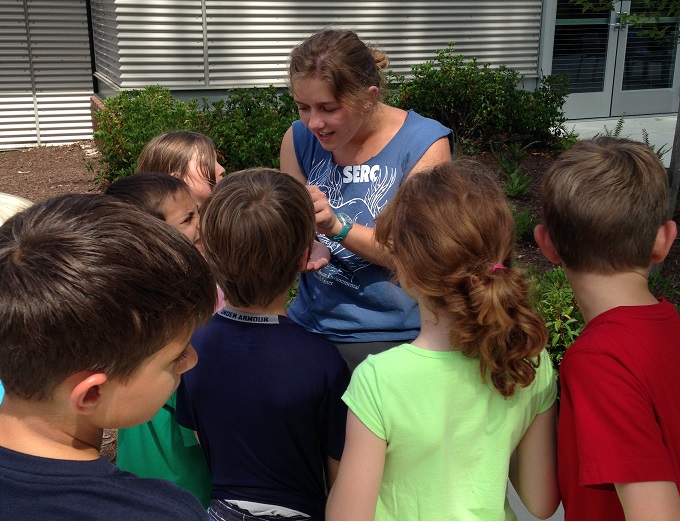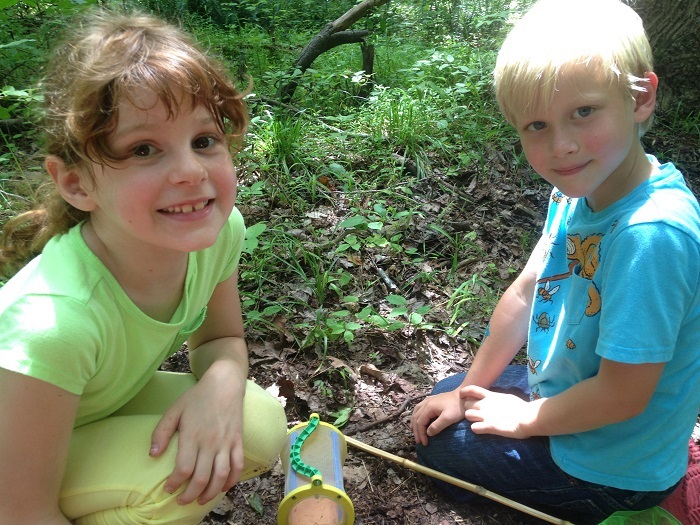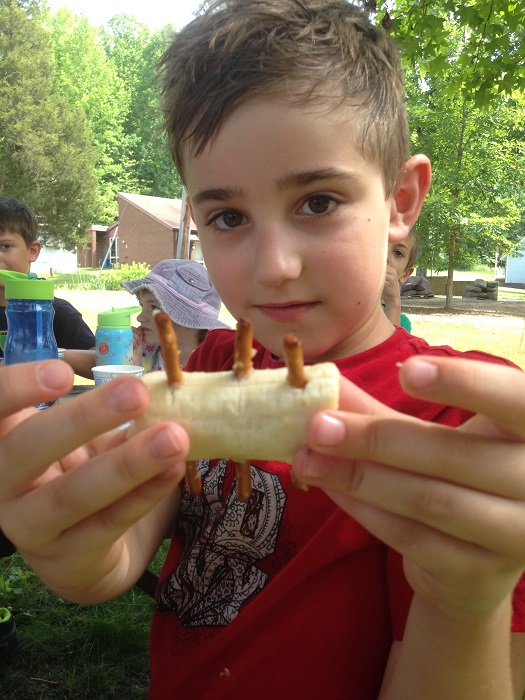by Chris Patrick
“Camp Discovery!” shouts Smithsonian Environmental Research Center (SERC) education intern Josie Whelan.
“SCIENCE NINJAS!” a dozen 6- to 8-year-old campers respond as they strike ninja-esque poses. This is a callback, used by the three education interns—Henry Lawson, Addie Schlussel, and Whelan—to grab the attention of talkative future first- and second-graders at Camp Discovery. The education interns designed Camp Discovery this year, organizing a week of visits to SERC’s forests, fields, docks, and wetlands to foster understanding and respect for nature in campers.
Today is Bug Day, and the campers are collecting insects. After the callback, the interns and 12 campers trek along a gravel road into SERC’s woods.
They’re joined by two high school volunteers and Free Kashon, an intern in the terrestrial ecology lab. Arriving in a patch of road splotched with shade and sun, Kashon, who studies insects, teaches the campers where to look for bugs, encouraging them to check the undersides of leaves, in the ground, and on tree trunks.

Intern Josie Whelan, rising senior at University of North Carolina at Asheville, holds up a locust’s exoskeleton a camper found near the Mathias Laboratory.
One camper asks, “What’s so important about mosquitoes?” Instead of answering, Schlussel probes, “Do you think mosquitoes are food for somebody else?”
“For spiders!” returns the camper.
“And what would we do without spiders?” said Schlussel.
Boom. Teaching moment. Though the campers have fun, they’re also learning, making discoveries about the natural world and how its inhabitants are interrelated.
When the bug collection begins, most of the Science Ninjas crouch and begin furiously scratching the dirt and gravel with the ends of their bug nets. Soon enough, excited shouts ring through the forest as campers catch ants, beetles, and butterflies.
In the final minutes, 7-year-old Emma, who had “never catched a bug,” scrambles to find one. Fortunately, 8-year-old Gavin helps her find and transfer a rollie pollie (also known as a pillbug—which is really a crustacean, not an insect) into her net. She beams.
The campers transfer all the caught insects to “bug boxes,” mesh cages with plastic handles and clear, swinging doors. They tote the bugs back to the Reed Education Center, where the education interns freeze them. After lunch, the campers look at the frozen insects under the microscope.

Intern Addie Schlussel, a rising junior at St. Mary’s College of Maryland, and 6-year-old Luke discuss why some insects live in the dirt.
They display a mixture of excitement and disgust to see bugs so close up. They compare the weave of a butterfly’s wings to fabric and gasp at the hairy appearance of a rollie pollie. A handful of campers voice their repulsion with hearty chorus of, “Eww!” when they thought they could see the bugs’ “skeletons.” The education interns seize this opportunity to explain insect exoskeletons.
The goal of Bug Day is to teach the students all about insects: where they are, what they look like, what they do, and why they’re valuable. Throughout the day, the interns describe the purpose of pollinators and why some caterpillars have spines (to prevent parasitic wasps from laying eggs in the caterpillar—eggs that later hatch into wasp babies who consume the caterpillar from the inside).
In addition to Bug Day, Camp Discovery included fish seining, frog catching, looking through oyster baskets, and visiting naked goby nests with interns from the marine and estuarine ecology lab.
The education interns have planned three other environmental camps for later this summer, each designed for a different age group. They have the same purpose as Camp Discovery: to teach campers about the environment. But the name “Science Ninjas” will be hard to beat.





